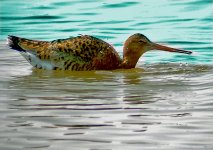NoSpringChicken
Well-known member

Thats a beauty Godwits are my favorite and you have a good one there. How far away was it?
For the balance issue you might look at the Swarovski balance rail I use it succesfully.
Keep up the good work and lets see some more lovely waders
I'm not too good at judging distances but I think it was about 25 metres away. I like photographing waders as they are normally quite big and don't move as fast as smaller birds!
I've had a look at details of the Swarovski balance rail and it sounds quite promising. When I've got a spare £35 I will probably get one. I have just bought a fixed length 20x lens to try instead of the zoom. It's a lot lighter and shorter, which means the camera can be moved nearer to the balance point of the scope, so a balance rail should get rid of the problem completely.
Ron





